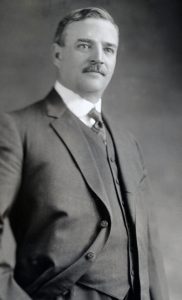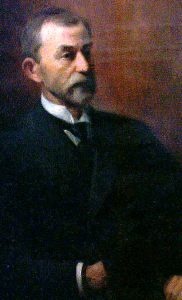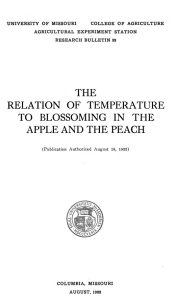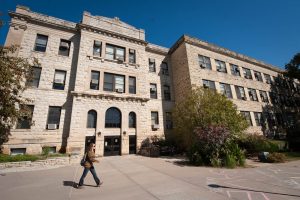
Henry Jackson Waters, named fourth Dean of the MU College of Agriculture in 1895, was no product of a prestigious eastern university as were the previous Deans. Only nine years separated his graduation from the Missouri College of Agriculture and his appointment. His youth (he was 29) was no issue, a rural Missouri newspaper of the day noted — “he has Missouri soil in his veins.”
Additionally, he was familiar with rural Missouri and had been a member of the state’s Board of Agriculture, an influential group of farmers and businesspeople who supported agriculture. He was considered a man of integrity, intelligence and common sense. Waters was respected, and was known for a passion for advancing agricultural education.
Grandson of a Famous Farmer
Waters was born on a farm near Center, Mo. (between Paris and Hannibal) on Nov. 25, 1865, the son of George Washington and Lavinia Jane (Smith) Waters.
His grandfather, George Washington Waters, was a Tennesseean, who moved to Missouri in 1829. George Washington Waters was famous throughout the Middle West as a Farmers Institute lecturer and as an agricultural writer. He paid his own expenses and visited every county and almost every farming community in Missouri. He was a regular contributor to agricultural publications and especially to Colman’s Rural World of St. Louis.
He donated practically all the material that made up Missouri’s agricultural exhibit at the World’s Fair in Chicago in 1893, performed a similar service as a commissioner from Missouri to the Omaha Exposition, and was assistant superintendent of the agricultural department from Missouri at the St. Louis Exposition.
He was active in the movement for the improvement of corn, and it is said that he did more to accomplish that purpose than any other man in Missouri. The young Henry J. Waters labored on the family’s Ralls County animal and crop operation until enrolling in the troubled MU College of Agriculture and Mechanical Arts.
Waters’ first job after graduation was assistant secretary of the Missouri State Board of Agriculture (1886-1891) – an impressive career leap even in the days when people with degrees in agriculture were rare. He resigned to become a MU professor of agriculture and assistant director of the MU Agricultural Experiment Station. Tired of the bickering between the University, College and Missouri Legislature over Morrill Act funding, he resigned for a professorship in Pennsylvania. He distinguished himself there. There were only three students at the Pennsylvania Experiment Station when he took charge. He visited every county in Pennsylvania and worked up an interest in the program until it had more than 100 pupils enrolled when he left the university.
Back to Missouri
When the third Dean of the MU College of Agriculture, Edward Porter, died of a heart attack, the MU Board of Curators and Board of Agriculture, in rare agreement, heavily recruited Waters to return to MU and continue Porter’s progress. In his 1944 book the History of the Missouri College of Agriculture, Frederick Mumford, fifth Dean of the College, admitted that Waters was a politically astute choice. He was a Missouri farmer and had the trust and support of other farmers angered over allegations of University misappropriation of Morrill Act funds intended for the College. The issue was so hot that the Legislature drafted the Murray Act to separate the College of Agriculture from the University and relocate it to another part of the state. Progress made by Porter to clean up the mess and upgrade College facilities was probably instrumental in the narrow defeat of that act. The onus was on Missourian Waters to fix things permanently.

The new Dean came back to Columbia with an important ally already in the MU President’s office. Richard Henry Jesse unequivocally supported the College. The College of Ag’s future was Jesse’s first order of business. In his inaugural address he asked the question, “What should the University develop first?” Answering himself, he said it was the continued development of the College of Agriculture. Jesse boldly announced his intention to elevate the College to academic and infrastructure standards equivalent to the best schools in the nation.
Gaining Support Through Research and Service
Mumford wrote that farmers remained suspicious of the University. Many even thought a formal education was unnecessary and distracted young people who should get practical on-the-job experience. Waters realized that the best way to gain their support was through research that directly improved crop and animal yields.
He hired a squadron of research faculty in areas such as agricultural chemistry, mechanical engineering, veterinary medicine, dairy science and plant science. They didn’t just teach, but addressed practical farm problems and published solutions in widely distributed bulletins. Waters sought, and got, endowments that created chairs in entomology and botany.
He oversaw construction of a horticultural greenhouse, and created a two-year practical course for young farmers who couldn’t stay for a four-year education. He also instituted two-week-long winter courses – an idea of Porter’s – that allowed farmers to catch up on the latest discoveries of direct value to them.
With Waters’ encouragement, the Missouri State Board of Agriculture recommended that new buildings be erected to foster research and education. This resulted in the Agriculture Building (now Mumford Hall), Whitten Hall, Switzler Hall and the Dairy Building (now Eckles Hall). As a way to highlight that these were agricultural buildings separate from the University, they were constructed of white limestone instead of the red brick of buildings around MU’s Quad.
Though touted today as one of its pride points, MU’s famous red and white campuses have their roots in a bitter money battle between the University and the College of Ag. The Legislature showed its confidence in the College’s research abilities by placing enforcement of the new fertilizer control law in the hands of the College’s Experiment Station. The College’s Ag Chemistry faculty were put in charge of all analytical and certification work.
Steady Growth in Public Sentiment
Waters’ and Jesse’s efforts soon bore fruit. In his 1896 annual report, the Experiment Station Supervisor noted that “there is a slow but steady growth of public sentiment in favor of more rational agricultural practices.”

In a moment of partnership that could not have existed a few years before, the Legislature, College, University and State Board of Agriculture in 1897 began work to establish a number of experiment sub-stations throughout the state to address regional challenges.
“The demand of communities for sub-stations was an indication that the people had come to fully appreciate the value of this class of research,” Mumford wrote. Today, CAFNR runs more than 20 of these stations. MU agricultural research became nationally famous in 1899 when Professor John Connaway of the Missouri Experiment Station, and Mark Francis of the Texas Experiment Station, announced an effective inoculation for Texas Fever, a tick-borne disease that killed 40-70 percent of cattle driven from Texas to Kansas. Suddenly, the MU College of Agriculture was garnering big headlines for something other than financial controversy.
Waters was making progress in education, as well. From 1891 to 1899 there had been just one graduate student at the MU College of Agriculture. In 1901 there were six.
With funds from the Legislature, Professor C.H. Eckles (Eckles Hall) of Iowa Agricultural College was named chair of the new dairy husbandry section – along with a $40,000 grant to build a livestock and dairy building (in addition to $40,000 for a horticulture building, now Whitten Hall). This was a big boost in governmental confidence in the College.
Just a few years before, the Legislature authorized $50,000 for the construction of Jesse Hall. In 1904, the Department of Rural Economics was established. The Board of Curators thought highly of the soil survey made by the College in 1906. “The most important new line of [research] undertaken is the State Soil Survey,” the Curators bragged.
By 1908, the MU College of Agriculture was a recognized success. Enrollment in that year was up 15 percent over 1907. The University Missourian newspaper reported that the growth of the College “has been so rapid that every inch of available space will be fully taxed by the time [a new] building is ready for occupancy.”
Building a National Reputation for MU Ag
Dean Waters began to develop a national reputation for the Missouri College of Agriculture. During 1902 he served as a visiting professor in animal nutrition at the Graduate School of Agriculture, University of Ohio. From 1901 to 1903 he assembled agricultural exhibits for the Louisiana Purchase Exposition at St. Louis. He served as director of the Missouri State Agricultural Exhibit at that fair during 1903-04.
The year following the Louisiana Purchase Exposition, Waters used a leave of absence from his University duties to go abroad and pursue studies at the universities of Leipzig and Zurich during 1904-05, under the eminent German authorities, Doctor Kelner and Doctor Zuntz. Waters’ success was being noticed. While in Europe he was offered the presidency of the new Agricultural College of California, but he declined that office. He similarly didn’t accept presidency of the Colorado Agricultural College. But he wasn’t adverse to a new job in the Sunflower State.
A Move to Kansas
In 1909, Waters resigned from Mizzou to accept the presidency of the Kansas State Agricultural College. “Missouri has certainly sustained a great loss in the resignation of Dean Waters,” the influential Colman’s Rural World magazine reported. The Columbia Herald newspaper said Waters was “recognized as the man who made the MU ag school the pride of Missouri and the envy of the other states.” In appreciation, MU conferred on Waters an honorary doctorate.

Waters was as succcessful in Kansas as he had been in Missouri. The official K-State history states:
Waters was a man of strong convictions and forceful personality. He recognized the value of a sense of stability, and was willing to hold his judgment in abeyance or defer action in minor matters for the sake of the greater good. He greatly magnified the duties of the deans, relinquishing to them all supervision of academic work, and placing much responsibility upon them in respect to the personnel of the departments, and allowances of funds to them. He also conferred freely on matters of policy.

“[He did] much to improve the course of instruction and render the work of the institution to the greatest practical avail,” the K-State history continued. After eight years as President of what is now K-State, Waters returned to Missouri to accept the editorship of the Weekly Kansas City Star (now The Star Magazine), living in the Country Club Plaza with his wife Margaret. In 1913, K-State dedicated Waters Hall – home of the KSU College of Agriculture – in his honor.
During World War I, Waters was chairman of the Council of National Defense for Kansas and continued to occupy that position until 1919. He was also state food administrator for Kansas in 1917. He traveled internationally, giving lectures and writing journal articles. After a brief illness in 1925, Waters died in October. One month later, the MU Board of Curators renamed the MU Agriculture Building as Waters Hall.